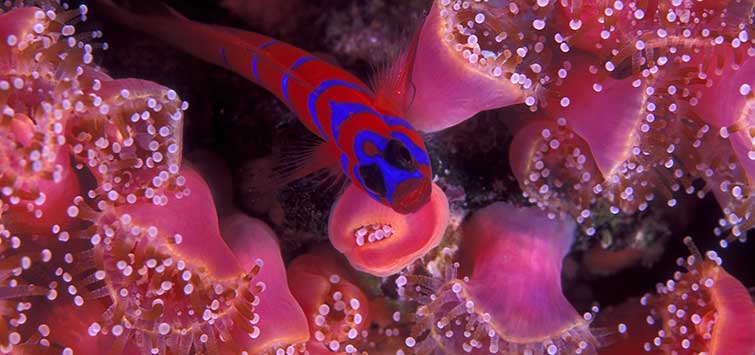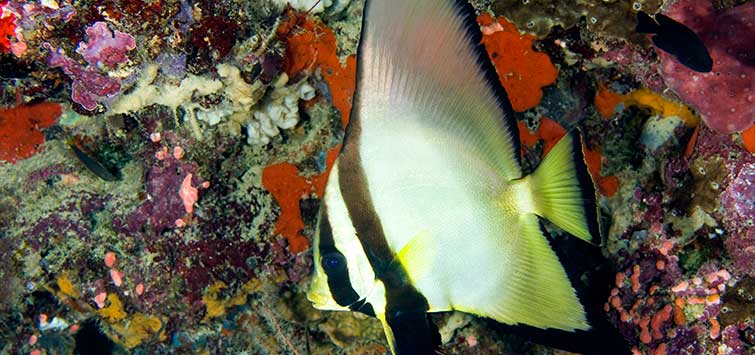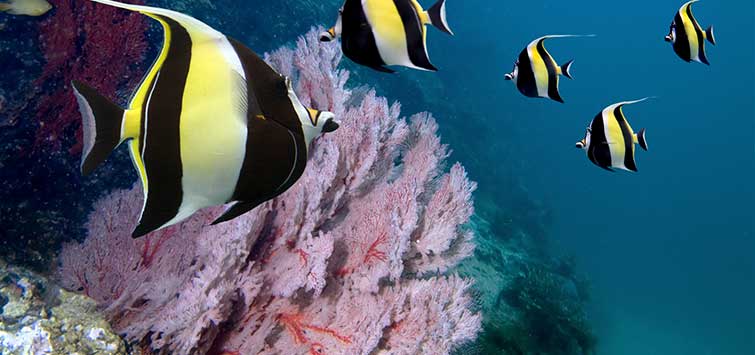Bad Choices: Saltwater Animals Commonly Offered in the Trade That Shouldn't Be
Author: Bob Fenner
It may be for sale, but that doesn't necessarily mean it's a good aquarium specimen. Our author provides a list of difficult fish and inverts sold at fish shops, including those that only survive in extreme conditions, are finicky eaters, or simply perish for reasons unknown.
Aquarium No-Nos
“What do you mean it shouldn’t be kept in an aquarium? It was offered for sale at a great fish store!”
Regardless of their availability, there are many species that the hobbyist often encounters that have dismal survival records in captivity. How can this be? Why would anyone sell organisms that typically don’t survive?
Defining Best to Worst
Throughout the years I’ve seen numerous models for describing the likelihood that livestock will stay alive. I like to use three simple categories—bad (the worst group, where more than half die within a week), better (the middle ground, with organisms that typically live more than a week, but with more than half that expire within about 30 days), and best (organisms of which a majority live for more than a month).
Are you surprised at how negative these categories seem to be? Are there really so many species kept by hobbyists that don’t live any longer than this, including some that usually die within a week? Yes! Admittedly, there are folks who have kept alive for years even the most difficult species (some of which are mentioned here), but I assure you—having lived the trade for some 40 years—that my characterizations hold up for practically all specimens. Here I will concentrate on some of the worst common offerings, but this will only be the tip of the bad-choices iceberg.
Fishes That Shouldn’t be in Your Aquarium
Sharks
There are over 350 species of shark in the world, and nearly all are inappropriate for home aquarium use due to size and required conditions, particularly temperature and water movement. However, some largely sedentary, smaller species can be housed long-term in larger systems of a few hundred gallons. The problem is that most of the sharks offered in the trade fall outside of this group. Disastrous choices include black-tip and nurse sharks that simply cannot live in glass rectangles.
Aquarists who simply must have a shark should realize that very special accommodations are required for them, and that they must opt for smaller, sedentary, tropical species like bamboo, epaulette, and some of the cat sharks. If you want to keep a temperate species like the California horn shark Heterodontus, the setup must include a powerful chiller.
Pinnatus Batfish
These are beautiful fish, but they rarely live more than a week or two in captivity. I have lost serious bets (well, serious pizza-and-beer bets anyway) trying to keep Platax pinnatus alive. Most die mysteriously, never taking in food in captivity. This is indeed a shame; some of this fish’s readily available congeners, such as the teira and orbicularis batfishes, are very sturdy aquarium choices for large tanks—they become “aqua dogs” in short order, imprinting on their keepers.
Catalina Gobies
Lythrypnus dalli is decidedly a coldwater species that lives neither long nor well in warm water. Unless you have a purposefully chilled cool- to coldwater biotopic setup, look to the many other beautiful (even tank-bred and -reared) goby species generally available. Some excellent choices include the diminutive cleaner gobies of the genera Gobiosoma and Elacatinus.
Cleaner Wrasses
There are a few Labroides cleaner wrasses that live more than a fortnight in captivity, but nearly all of these obligate cleaners die within a few weeks of collection. It would be better to leave these in the seas where they do a lot of good and instead employ the purposeful and much hardier cleaner gobies, Lysmata shrimp, or one of the many other responsible choices of non-obligate cleaner organisms.
Parrotfishes
Where does the coral sand we see on the world’s reefs come from? Most is from coral skeletons recycled by the feeding activity of the Scaridae (the parrotfish family). Though a few species and individuals have shown promise in accepting other foods, most individuals shrink and fade away from malnutrition in short order during captivity. A much better choice is to select among the medium-sized wrasses (their closely related kin), such as Cetoscarus bicolor and Halichoeres hortulanus.
Corallivorous Butterflyfishes
A wide range of feeding strategies is found among the chaetodontids (butterflyfishes), with some species being omnivorous to largely planktivorous, and many of these can do well in the aquarium. Unfortunately, there are also many species that almost exclusively feed on live coral polyps and rarely take any other food. These obligate corallivores make their way into the trade just the same, often being offered cheaply and identified as “miscellaneous butterflies.” Avoid these unless you have a very large and established stony-coral reef system that you want grazed to death.
Some of the more notorious fish in this group are Chaetodon baronessa (eastern triangular or baroness butterflyfish), C. bennetti (Bennett’s butterflyfish), C. lunulatus (redfin butterflyfish), C. meyeri (Meyer’s butterflyfish), C. octofasciatus (eight-banded butterflyfish), C. plebeius (bluespot butterflyfish), and C. vagabundus (vagabond or crisscross butterflyfish). Avoid these and select sturdier and more broad-based feeders like C. auriga (threadfin butterflyfish), C. fasciatus (raccoon butterflyfish), one of the hardier Heniochus species, or the pricey though super-hardy beauties of the subgenus Roaops.
Sweetlips
They’re so cute when they’re small—but heck, so was I! Almost all of these members of the grunt family Haemulidae die without apparent cause. Give them a break and leave them in the sea. The most commonly offered species from this doomed group is Plectorhinchus chaetodonoides. If you want a good-looking relative of these fishes, consider Anisotremus virginicus (Atlantic porkfish) or Haemulon flavolineatum (French grunt).
Sand Tilefishes
These are some really neat fishes that cruise along the substrate and dive into it if they sense danger and can’t just swim away. This behavior is their undoing, along with many achieving large sizes. Most malacanthids (from the family name Malacanthidae) die from physical damage, stress, or from jumping out of the tank. Fishes that use the same habitat without the terminal skittishness are the many wrasses of the genus Halichoeres.
Moorish Idols
Due to the better collecting, handling, and shipping practices of recent years, Zanclus cornutus are arriving in better shape. I have seen a few that have been kept for more than a year, but most idols still perish in a week, and it’s likely that less than a single percent would live past a month. It is much better to select a hardy look-alike, such as the two “poor man’s Moorish idols” of the genus Heniochus.
Wild-Collected Specimens to Avoid
Seahorses and Clownfishes
There is almost a diametrically opposed relationship between most groups of wild-collected versus tank-bred and -reared organisms, and this reciprocal relationship is no plainer than with the ever-popular families of seahorses (Syngnathidae) and clownfishes (family Pomacentridae, subfamily Amphiprioninae). Avoid wild-collected specimens, as these rarely live for any time in captive care. They’re also notorious for bringing in parasitic disease (oh joy), infecting your other fish. Yes, captive-produced specimens are generally smaller and slightly more expensive to purchase, but at least they live!
Invertebrates to Avoid
Anemones
Anemones are generally very poor choices for the home aquarium, but some are even worse than others. Every few years, a few species of non-tropical anemones make their way back into the market, such as Anthopleura, Metridium, and Tealia. These simply cannot live in warm water and need designated species setups or specialized settings. If you must have an anemone, try a Condylactis species (that have a relatively faster replacement rate in the wild) or a bubble-tip/rose anemone that’s been captive-produced via asexual fission.
Goniopora
I find it amazing how flower pot corals are still the most popular of stony corals after all these years, yet their survivability has not improved. Why? I guess it’s because this genus is often quite populous in both shallow water and coastal (nutrient-rich) environments, and it’s pretty easy to whack colony bumps off their larger masses. But the fact remains, they almost never survive in the cleaner environments of your typical aquarium. Their proper care is not simple—Goniopora must have each of their polyps constantly fed in order to survive. Avoid this poritid!
Nudibranchs
Many naked gill slugs are breathtakingly beautiful and easy to collect in the wild. Unfortunately, most have specialized diets and are extremely picky about what species they’ll eat. Regardless of what you’ve heard, most are inevitably doomed to starve. Unless you know exactly what species you are purchasing and can provide a steady supply of the proper food organisms, steer clear of nudibranchs.
Coldwater Snails and Sea Hares
Here’s another group that cycles through our trade every several years—members include bubble, moon, and other coldwater snails, plus cool- to coldwater sea hares. Can they live in tropical setups? No. Will they make a deadly stew of your system when (and not if) they die? Perhaps. Instead, look for tropical species.
Flame Scallops
These common offerings are actually pen shells. They are non-hardy filter feeders that almost invariably starve in captive settings. It’s best to avoid bivalves of all species in anything other than well-established systems of good size and low filter-feeding biomass, with healthy and large refugiums. Most die of starvation.
Gadzooks, Cukes!
They’re often offered for sale, but Pseudocolochirus violaceus (Australian sea apple, sea apple, violet sea cucumber) is a time bomb in the aquarium. This animal can be extremely toxic if disturbed, and should definitely not be kept with sea urchins or predatory sea stars (Asthenosoma, Protoreaster, etc.). These sea apples are also sensitive to poor or changing water quality. They are largely filter feeders. These (and other toxic, sticky Cuvierian-tubule-packing larger species of sea cucumbers) are virtual time bombs that can wipe out entire systems, even store-sized layouts, when disturbed. Look for smaller, less toxic species like Colochirus robustus or Pentacta anceps.
Linckia and Protoreaster (Chocolate Chip) Starfish
Despite their availability, the vast majority of these sea stars don’t survive in captivity for a variety of reasons. These include poor handling, polluted conditions, lack of food through the chain of custody, being placed in unstable and poorly established settings, and the dearth of useful foods. For an alternative, look to much more desirable and hardy specimens like the smaller Fromia or Nardoa species.
Coldwater Algae
With so many truly gorgeous tropical species to choose from, you’d think that the trade would outright avoid cool- to coldwater-only varieties. Unfortunately, these do cycle into fish stores every few years, particularly some of the California brown and red kelps. Unless you have a refrigerated setup, go with tropical species.
Is That All?
Not by a long-shot. I have only included the more susceptible species, and I’ve also left out notes on how to select the better of these—there are regional survival differences of great note. Nor have we detailed organisms that might be best avoided on other bases, like their likelihood to envenomate you (the lions and their relatives, saltwater catfishes, rabbitfishes, tangs) or toxify your tank (many puffers, cowfish, soapfishes, etc.). I can’t emphasize enough that a good consumer—yes, you!—must take the initiative to learn, ahead of purchasing, what species are best to keep, what to avoid, and how to go about picking out the best specimens of the species you settle on.
Why Are These Animals Offered?
If they don’t live, why does the trade persist in offering these and other low-survival species to the public? The simplest answer is probably obvious: they sell. If no one bought them, the stores would stop carrying poor choices in livestock! After all, they’re in the business to make money.
Suppliers (wholesalers, jobbers, collectors) continue to offer these species to retailers, once again, due to established and ongoing demand. I like to call this cycle of idiotic attrition the “flounder effect” to inject a bit of needed comedy to an otherwise self-defeating and tragic relationship. (This play on words builds on the “founder effect,” which relates to someone initially finding a beautiful, interesting, and abundant organism, then devising capture, holding, and shipping techniques for it.) “But,” you inquire, “if it doesn’t live…?”
But there’s more to this cycle. It turns out that this hobby loses most of its members and gains new ones each year, and it churns and burns through most of its retailers and their staffs in about two years. Hence, the poor-choices scenario repeats itself with new and relatively unaware customers on a perpetual basis. Oh, if only there was a way out of this nonsense! But there is, and you’re holding it in your hands—you just need to educate yourself with the right information.
Now that you’re a bit more aware of the situation, hopefully you’ll make more of an effort to investigate before you buy. There really is a huge body of useful and easily accessible information in books, magazines, hobbyist get-togethers (clubs, conferences), stores, people that you can meet through the last two, and the Internet! The last takes a discerning mind (and a thick hide at times), but it can yield some very useful information in a timely manner. If only more fish stores would have Internet connections available in their shops!
Choose Wisely
Is there some grand conspiracy to offer hobbyists bad species—even bad specimens of good to better species—so that the animals will die and cause them to come back for more? Surely not. Rather, the suppliers are doing what free markets do—supplying a demand—albeit in this case with missing knowledge. Do your part as a conscientious consumer and skip these animals as purchases. Actually, you can go even further and make a point to inform your stores of any inappropriate stock they may be carrying. This is the most reasonable way/means to break this cycle of pointless mortality, and to better enjoy this wonderful hobby!
References
Burgess, W. E. 1978. “Salts from the Seven Seas: The Right Size Fishes.” Tropical Fish Hobbyist, February 1978.
Dodds, K. 2008. “Still Impossible After All These Years: Keeping Moorish Idols.” Tropical Fish Hobbyist, January 2008.
Dow, S.1986. “A Math Model for Estimating Aquarium Capacity.” Tropical Fish Hobbyist, November 1986.
Fatherree, J. 2005. “Clownfishes and their Hosts.” Tropical Fish Hobbyist, January 2005.
Fenner, R. 1996. “Butterflies You Don’t Want.” Tropical Fish Hobbyist, September 1996.
Fenner, R. 1995. “The Conscientious Marine Aquarist, with Notes on Cleaner Wrasses.” Tropical Fish Hobbyist, May 1995.
Fenner, R. 1998. “Going Batty! Bats, but not Spades.” Tropical Fish Hobbyist, March 1998.
Fenner, R. 2003. “A Good Choice for Cool- to Coldwater Reefs: Lythrypnus dalli, the Catalina or Blue-Banded Goby.” Tropical Fish Hobbyist, April 2003.
Fenner, R. 1996. “Nudibranchs: The Beautiful Naked-Gilled Sea Slugs.” Tropical Fish Hobbyist, February 1996.
Fenner, R. 1996. “Parrotfish Pitfalls.” Tropical Fish Hobbyist, January 1996.
Fenner, R. 1996. “Shark Attack!” Tropical Fish Hobbyist, May 1996.
Fenner, R. 2008. The Conscientious Marine Aquarist. 2nd edition. TFH/Microcosm Professional Series, Neptune City, NJ.
See the full article on TFH Digital http://www.tfhdigital.com/tfh/200810/#pg98

.png?h=595&iar=0&w=2781&hash=5FD5E69473BCC22199FBFA2FB71B6033)



